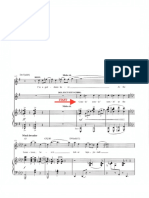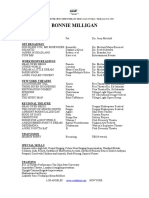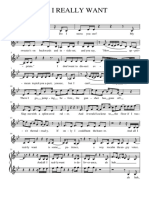African Art As Communication
African Art As Communication
Uploaded by
Sahu RaCopyright:
Available Formats
African Art As Communication
African Art As Communication
Uploaded by
Sahu RaOriginal Title
Copyright
Available Formats
Share this document
Did you find this document useful?
Is this content inappropriate?
Copyright:
Available Formats
African Art As Communication
African Art As Communication
Uploaded by
Sahu RaCopyright:
Available Formats
George Emeka Ekwuru
83
AFRICAN TRADITIONAL ARTS AND THE MYSTICAL AESTHETICS OF SYMBOLIC COMMUNICATION George Emeka Ekwuru Introduction In the judgment of James Clifford, the exotic is now nearby, but it is equally true that exotic arts are yet to be properly interpreted and understood in the original frameworks of meaning. Considering the complex ideological characteristics of the African traditional worldview and religious traditions, the various studies of African traditional arts that embody and mirror such complexities are particularly bound to present notable conceptual difficulties, in every attempt to understand their basic structures of meaning. In other words, every attempt made to interpret the traditional artistic forms and symbols outside their original situations of meaning create certain hermeneutic difficulties. Thus, attempts made by certain scholars to de-contextualize and confer on African traditional arts the forms of universal symbolic language met with various kinds of hermeneutic difficulties. For instance, the recognition that most of the symbolic features in African traditional art are context-bound and the fact that in the arrangement of forms the ideology controls technique make a rather superficial interpretation of their symbolic forms highly inadequate. Thus, acknowledging this essential problem in the interpretation of African traditional arts, Meauze declares conclusively:
We shall have to wait for the various trends in the analysis of art to converge which incidentally is underway in order to arrive at a synthesis to which the Africans, prompted by their new faith and method and with consciousness to recuperate their past cultural values, will contribute new concepts arising from original creative centres. This, however, will not be achieved in the near future, for 1 many gaps must be filled before such a stage is reached.
It is the recognition of this basic difficulty of interpretation that made scholars of African arts to seek for ways of explaining the symbolic forms of the African traditional arts. Through this means, African scholars, with better knowledge of their tribes and the nuances of their societal structures, are helping people to understand the expressive roles of the tribal arts from an insiders point of view. Thus, from the cumulative knowledge of the extensive studies carried out by different scholars on different tribes of Africa, we can confidently make a collective statement about the unique character of their symbolic mode of communication and meaning. In the following pages of this essay, we shall explain the nature of such a unique characteristic of symbolic communication
P. Meauze, African Art (London: Weidenfield and Nicolson, 1968), 10.
84
African Traditional Arts and the Mystical Aesthetics of Symbolic Communication
that is peculiar to African traditional arts, which is often described as a mystical form of aesthetics. The Problem of Determining the Nature of the Traditional Art With the unique roles that art played in the African traditional cultures, the application of what is generally called art to the African traditional artefacts raises both linguistic and ideological problems. In this case, therefore, for any serious study of what is conventionally known today as the African art, some basic preliminary clarifications are required. To begin with, the in-road of the African art into the world family of arts sparked off some linguistic and ideological debates, which were only settled with the indeterminate extensiveness of the meaning of the term art. For, when the English word art is considered in its restricted sense, with which the common slogan of art for art sake has a determinate hold, it becomes extremely difficult to define the African polyvalence forms, as true art. It is with this understanding that the Nigerian Scholar, J.O. Ojo, pointedly remarked that in considering the place of art in African cultures, it must be stressed that the object we now refer to as art was not originally destined to be displayed in houses or museum for aesthetic contemplation, like drawings, painting and other products of modern European art.2 Thus, it could be strongly contested that the concept of art in its conventional contemporary usage was something unknown and strange to the African traditional cultures. Equally, in this connection, it should be noted that what is today abstracted as African art, was simply known as the African traditional art. Strictly speaking, one cannot talk about the African art in the same sense that European or the American arts are variously represented. As it were, Africa has no general form of art, and what is called the tribal art today stands in direct opposition to the so-called touristic, detribalized or internationalized arts. Most importantly, it must also be indicated that the tribal art is used to mark geographical boundaries, as it refers to the regions from which the black Africans and their artistic tendencies produced the various forms of arts like music, poetry, dance, drama, sculpture/wood carvings and paintings. The awareness of the specific differences in the African artistic and aesthetic considerations has in recent years led to remarkable field-studies as to what and how the African arts should be conceived and represented. Till the present moment, most of the Western aesthetic categories have not been accepted to represent the African aesthetic experience; the African tribal art is meant to stand between what the West calls art in the broad sense, and the sacred icons in
2
O. J. Ojo, Art In Traditional African Culture, in African History and Culture. Ed. Richard Olaniyan (Lagos: Longman, 1982), 200.
George Emeka Ekwuru
85
their specific religious functional differences. Apart from their artistic natures, most of the African traditional arts have certain underlying religious motifs. Thus, the significant aspect of every African art, says K. C. Anyanwu, does not lie in the use and styles of the art, but in the meaning and ideas which give birth to the artistic expressions. This is why they have a unique form of symbolic communication. And this is why such a symbolic communication is said to be mystical in its religious aesthetic characteristics. The Socio-religious Characteristics of the African Traditional Arts The socio-religious characteristics of the African arts originate from myths that are regarded as the timeless sources of the African traditional thought. The acknowledgement of this fact made Sue Picton to say that one must always bear in mind that the art forms and styles existing in Africa today cannot be understood from a purely aesthetic view point, but must be seen in their particular history, social and economic contexts. And as if to corroborate this point, J. O. Ojo affirms that African tribal arts in their socially defined aesthetic functionality assume iconographic roles as referents to some higher ideological ends. Although, the forms and functions of art vary from one African society to another, it must be noted that African art objects are not separable from other aspects of the socio-cultural life. The tribal arts, in their predominantly religious dimension, serve to substantiate the religious realities by giving visible and tangible forms to superhuman entities. Expressing this aspect of the tribal art, Abadom writes:
Art in Nigeria and in other parts of African was viewed as a functional element. Religion has to a great extent influenced the production of art works in Nigeria. The belief in the supreme Being, and the lesser gods as well as in dead ancestors and heroes who can also graduate to position of gods and who participate in the world of the living have been often transformed into sculptural representatives 3 and other art forms.
In their religious functional natures, the images may depict the sacred in its oneness, and the plurality of its varied forms of apparitions. They also depict the world as the stage of the divine action, as the realm of the diabolical or the battleground of the life-forces. Equally, through varied modes, arts portray forms of evil, maledictions, and the various ritual means of placating evil retribution, or as a means of attaining salvation. It is from this point of view that Anyanwu remarked that African arts express the essentials their original ideology, whether we refer to art objects, or to music, or to dance, to any visible art form. All of them, he says, have other invisible relations associated with them. For every art
3
M. C., Abadom, Artistic Heritage of Nigeria, in Nigeria Histroy and Cultural Heritage, edited by E. Ikenga Metuh, & Olowo Ojioade (Jos: Ehudero Nig. Ltd 1990), 65.
86
African Traditional Arts and the Mystical Aesthetics of Symbolic Communication
object is believed to have a mythical background. These forms of mythicoreligious backgrounds are the ideologies that control the technical rendition of their visual forms. In this case, the artist is bound to deviate from the purely western artistic canons of balance, unison and proportionality. Anyanwu puts it this way:
The African artist deviates from the principles of the western aesthetics namely, proportionality, balance, form, etc. If the proportionality is the criterion of beauty then African art is not beautiful. We do not see any proportion between the head, belly, legs, mouth, eyes, height, and size of statues, statuettes, masks etc. African artists lay emphasis on symbolic representations of mythical forces not on proportionality. So we do not look for the beauty of his works 4 on their proportional nature, but in their symbolic meanings .
African traditional arts are not meant to be appreciated solely in terms of their structural forms and modes but over and above all, from the point of view of their symbolic representations and meanings. The artistic forms and the mode of their display within the traditional societal set-up constitute an effective means of deeper spiritual interactions between the community and the divine beings. The Traditional Arts as Systems of Symbolic Communication The traditional arts were constituted as systems of symbolic communication and communion between the living, the dead and the deities of the land. Obviously, in an oral culture where written scripts were lacking, art, in all its forms, was the only available medium through which the traditional man could exercise the rational tendency of articulating and ordering the chaos of human experience. The artist, then, within the oral traditional culture was seen as one who with his natural talent or as a result of practice or education created (fashioned, composed etc.) a work of art. The African traditional artist took off from the principles of his cultural ideology to transform and communicate his own elaborate experience, knowledge, insight, feelings etc, to the rest of the tribe; by projecting them onto some external signs of symbolic forms. So, what the artist in this case designed and communicated was not only the emotional response as it is the case in the civilized nations, but an articulate thought-project meant to express and communicate the deeper realities of the land. Considering the level of cultural consciousness of the age and time, the ability to communicate the embedded cultural ideological knowledge and experience, with an added profundity and originality, constituted the creativity of the artist. Thus, from the point of view of the artist, the traditional art, as a creative process, was meant
K. C., Anyanwu, Artistic and Aesthetic Experience, in A.E. Ruch, Omi
and K.C. Anyanwu, African Philosophy (Rome: Catholic Book Agency, 1984), 270-286.
George Emeka Ekwuru
87
to express and communicate the divine knowledge of the spiritual ideals of the community. In the traditional societies, where the modern sense of literacy was lacking, where abstract thought and abstract imagination were not highly developed, and where the memory was the only store-house for knowledge, historical facts, feelings and emotions; the memory, therefore, was aided by the symbolic images. The archetypical images, which the artist elaborately represented in their various forms, became readable texts and symbolic forms of much value that could be expanded in volumes. Therefore, the main business of art in the traditional African culture was to substantiate, concretise and objectify, in the most visible way, the realities which confronted the people in the events of their daily lives. In this way, African traditional arts were devoted to the service of religion and the enhancement of the moral and social lives of the people. They created and established means and opportunities for closer relationship with the forces on whom the people believed that their survival, welfare and progress depended. Generally speaking, the African traditional artist used the medium of art to give expression to the beliefs, values and attitudes which the community approved and cherished. Therefore, while creating values through his work, the individual artist expressed, not only his individual preferences and feelings but also the communal values of the society. His messages were usually unmistakably clear because of their symbolic realisms since traditional themes already existing in mythologies and folklore are symbolically given substantial forms in visual arts - painting, carving, sculpture, moulding. Besides under the realisms are hidden certain deeper beliefs and ideas which only the man who shares the same basic values and philosophy and the same environment with the artist can unravel and appreciate.5 The Mystical Nature of Symbolic Communication in the African Traditional Arts The symbolic images, in their different natural complexities, were much used in traditional African arts. And they were often thought to possess magical powers, as in carving of the totem or protective animal from which the tribe was supposed to have descended. The traditional arts were in effect, within the religious contexts of their functions, regarded as the mediators and the real representations of the Holy in certain conventional and standardized forms. The artistic symbolism of the traditional arts in the final analysis seems to attempt, in their various forms, an objective concentration of experience in the transcendental world. In the formulation of these symbols, the artist combines and condenses the mythical images of the religious tradition with some historical
5
T. U. Nwala, Igbo Philosophy (Ikeja: Literammed Pub. Nig. Ltd., 1985), 199-200.
88
African Traditional Arts and the Mystical Aesthetics of Symbolic Communication
facts and events. In this way, most of the traditional artistic symbolisms have long established relationships with myths that popularised them. For instance, the myths of cosmogony (myth of the origin of the world), theogony (myth of the origin of the gods), and anthropogony (the myth of the origin of man), in their respective formulations, ascribe meaning and being to the different items of their content. It means that the traditional arts in their varied forms of meaning within the religious contexts bear the imprint of religious teaching and mythical dogmas, social and ethical values. With this iconographic dimension of the tribal arts, within a ritual context, the symbolisms of these arts in their spiritual inspirational modes elicit in the community of worshippers certain predictable responses. This particular role of tribal arts corresponds to the nature and functions to which Babolin ascribes to Icons, when he says affirms:
The Icon is capable of leading to a true knowledge. It is true of Icon because it offers the reality not as it is seen, but as it is known, in the manner in which a child stands before his drawings. We may, therefore, affirm that the Icon is a visible word that provokes mediation and more contemplation because it is not properly a work of art, but a proclamation of the work of God. The Icon is a constant invitation to a lectio divina on the mysteries celebrated by the church in the liturgical cycle of the year.6
The essential communicative roles and functions, which Babolin and Pfeiffer in their different books, ascribe to iconographic images in the Christian Churches help to understand and conceptualise the communicative roles and functions of the African arts. In the traditional culture, the archetypical symbols, which the traditional arts embody in all their various forms, serve as communicative means of transformation and regeneration. Through the processes of the ritual act in which these symbols are utilized in their different modes, with the combination of some other ritual elements (like the appropriate rhythmic gestures and physical movements, the verbal recitations and adequate musical incantations), the worshipping community is mystically transformed and regenerated. Describing these archetypical symbols, Benjamin Ray puts it thus:
By archetypical symbols, I mean sacred images whether they be gods, ancestors, sacred actions or things which make-up the traditional universe. Such images, enshrined and communicated in myths and rituals, provide a net-work of symbolic forms, uniting, social, ecological, and conceptual elements into locally bounded cultural systems. They give order to experience by forming the world in terms of sacred figures and patterns. Thus encapsulated within local universe of archetypical forms, traditional African thought tends to abolish both time and chance by shaping experience to integrate manual and ritual patterns.7
6
Sante Babolin, Icona e Conoscenza (Padova: Gregorian Libreria Editrice, 1990), 125. C. B. Ray, Symbols, Rituals, And Community (London: Princeton University Press, 1952), 16
George Emeka Ekwuru
89
In this case, as Benjamin indicated, the archetypical symbols act as models for behaviour as well as modes of thought. They help to re-enact the deeds of gods, to become possessed by divinities, to manipulate sacred objects and to speak sacred words. This in turn is the bid to conform experience to normative patterns of meanings and thereby control and renew the shape and destiny of the word. The African arts within a ritual context are seen in a deeper way than just mere iconographic presence. They effect the real presence of the divine. In their symbolic embodiment of the metaphysic of presence, they permeate and suffuse the entire human community in a form of mystic union that actualises salvation or emancipating experience. The human community knows that through ritual man transcends himself and communicates directly with the divine; the coming of the divinity to man and of man to divinity happens repeatedly with equal validity on almost every ritual occasion.8 Conclusion African traditional arts, with their mythico-religious forms and modes, constituted an effective system of symbolic communication. Works of art were not simply seen as mere aesthetic objects, but were vectors of deeper ideological forms of meaning. Therefore, within the dynamics of the ritual process, through the presence of the artistic symbols, the salvation experience was always made a present reality. The meaning of this was derived from the fact that within the ritual process, the transition from the profane to the sacred, from man to divinity, from moral conflict to moral unity was actualised in a harmonic symbiotic existence. In this way, the symbolic words, tones, gestures, signs, and statues were unified. The reality of salvation in the African traditional religions, as seen in essential pragmatism of their various modes of worship, was a matter of hic et nunc. This is why Benjamin Ray says that mythical symbols and ritual arts are decidedly instrumental. They not only say what reality is, but they also shape the world to conform with this reality.29 The African artistic symbols in their unique functional roles have, as their ultimate goal, the attainment of spiritual communication the deepest form of aesthetic communion between the divine and the human community. Thus, through their presence in the day-to-day existence of the communal life, and especially, within the context of ritual celebration, the original primordiality is re-enacted and salvifically re-lived. It is, therefore, in and through these ritual processes of re-enactment of the symbolic communion between the divine and the human community that the aesthetic forms of the arts are evaluated and better appreciated.
8 29
Ibid. Ibid.
90
African Traditional Arts and the Mystical Aesthetics of Symbolic Communication
Bibliography Abadom, M.C., Artistic Heritage of Nigeria, in Nigeria Histroy and Cultural Heritage, edited by E. Ikenga Metuh, & Olowo Ojioade. Jos: Ehudero Nig. Ltd 1990, 65. Abiodum, Roland, Ife Art Objects: An Interpretation Based on Oral Tradition. Ile-Ife: University of Ife, 1975. Anyangaor, C. E. The Creative Arts and the Nigerian Personality, in Nigerian Cultural Heritage edited by. Ikenga-Metuh Emefie and Olowo Ojoade, Jos: IMICO Pub., 1990. Anyanwu, K. C., Artistic and Aesthetic Experience, in A.E. Ruch, Omi and K.C. Anyanwu, African Philosophy. Rome: Catholic Book Agency, 1984, 270-286. Babolin, Sante. Icona e Conoscenza. Padova: Gregorian Libreria Editrice, 1990. Meauze, Pierre. African Art. London: Weidenfield and Nicolson, 1981. Nwala, T. Uzodinma, Igbo Philosophy. Ikeja: Literammed Pub. Nig. Ltd., 1985. Nwoko, Mathew, Philosophy of Technology and Nigeria. Enugu: P. Asmog Press, 1992. Ojo, O. J., Art in Traditional African Culture, in African History and Culture. Ed. Richard Olaniyan, Lagos: Longman, 1982, 200-236. Ray, C. Benjamin, Symbols, Rituals, and Community. London: Princeto University, 1952,
You might also like
- Central Park From See What I Wanna SeeDocument11 pagesCentral Park From See What I Wanna Seejaubroubrauvessi-1336No ratings yet
- 02 - Cantata For A First DateDocument10 pages02 - Cantata For A First DateBilly James St JohnNo ratings yet
- West of Words - Alice by HeartDocument13 pagesWest of Words - Alice by HeartkleenexNo ratings yet
- CHARLIE - Step One - CallbackDocument11 pagesCHARLIE - Step One - CallbackwaldodougoNo ratings yet
- Angels in America Louis MonologueDocument1 pageAngels in America Louis Monologuealioliver9No ratings yet
- Vocal Score: Beggar's Holiday, Duke Ellington Broadway musical: Beggar's Holiday, the only Broadway Musical by Duke EllingtonFrom EverandVocal Score: Beggar's Holiday, Duke Ellington Broadway musical: Beggar's Holiday, the only Broadway Musical by Duke EllingtonNo ratings yet
- Shared Reading:: The Great EightDocument1 pageShared Reading:: The Great EightursulaNo ratings yet
- Lydia Luce - Love You TrueDocument3 pagesLydia Luce - Love You TrueCariss CrosbieNo ratings yet
- High Fidelity - Ready To SettleDocument15 pagesHigh Fidelity - Ready To SettleMarco SciortinoNo ratings yet
- 25th Annual Putnam County Spelling Bee PDFDocument1 page25th Annual Putnam County Spelling Bee PDFAndrei PrunilaNo ratings yet
- ACTIONS 2 4 2018 Staged Reading TextDocument46 pagesACTIONS 2 4 2018 Staged Reading TextCassie SnowaNo ratings yet
- Current Economic Conditions by Don ZolidisDocument2 pagesCurrent Economic Conditions by Don ZolidisKaylaNo ratings yet
- Monologues From BunheadsDocument7 pagesMonologues From BunheadsChristina CannillaNo ratings yet
- Mark of The Beast Saturn Star of DavidDocument23 pagesMark of The Beast Saturn Star of DavidThorsteinn Thorsteinsson100% (4)
- Clubs and DiamondsDocument6 pagesClubs and DiamondsBeccaBarrettNo ratings yet
- Eden - Clown BibleDocument1 pageEden - Clown BibleKaory Sax100% (1)
- Maybe (Annie)Document1 pageMaybe (Annie)Esther PíscoreNo ratings yet
- Born Again! What Do You Mean? Free!Document40 pagesBorn Again! What Do You Mean? Free!Charles and Frances Hunter100% (2)
- Invocations To The GodsDocument8 pagesInvocations To The Godskcykim4No ratings yet
- I'm Your Man RepDocument2 pagesI'm Your Man RepAnnie SoreyNo ratings yet
- Mathieu Whitman: HEIGHT: 5'7" ETHNICITY: Cuban-American VOICE: TenorDocument1 pageMathieu Whitman: HEIGHT: 5'7" ETHNICITY: Cuban-American VOICE: TenorMariel BlattNo ratings yet
- IizukaDocument4 pagesIizukamarymary14No ratings yet
- Loose EndsDocument13 pagesLoose EndsOlly Wood0% (1)
- I Dont Care MuchDocument1 pageI Dont Care Muchchilaquiles123No ratings yet
- CCHS Drama - All Shook Up ProgramDocument16 pagesCCHS Drama - All Shook Up ProgramMatthew NguyenNo ratings yet
- I Know Things Now Lyrics PDFDocument1 pageI Know Things Now Lyrics PDFKara LindsayNo ratings yet
- Let Things Go - Ordinary DaysDocument2 pagesLet Things Go - Ordinary DaysWillemijn BöckerNo ratings yet
- Two by TwoDocument3 pagesTwo by TwoMaria CarnariusNo ratings yet
- Acute ExposureDocument57 pagesAcute ExposureRocking PanduNo ratings yet
- Hard Times The Adult MusicalDocument5 pagesHard Times The Adult Musical方科惠No ratings yet
- Orgia - Thinking of HimDocument2 pagesOrgia - Thinking of HimasiazboyNo ratings yet
- Little Mix Cheat Codes - Only YouDocument3 pagesLittle Mix Cheat Codes - Only Youbarbara igor uribeNo ratings yet
- Damn Yankees and The 1950s Man: You Gotta Have (Loyalty, An Escape ClauseDocument3 pagesDamn Yankees and The 1950s Man: You Gotta Have (Loyalty, An Escape ClauseAmy BianchiNo ratings yet
- Hometown Heros Ticker Tape ParadeDocument3 pagesHometown Heros Ticker Tape ParadeAlan Santoyo LapinelNo ratings yet
- Fester's ManifestoDocument1 pageFester's ManifestoChristina CannillaNo ratings yet
- Composer ListDocument3 pagesComposer ListAndrew FrankNo ratings yet
- Bonnie ResumeDocument2 pagesBonnie Resumeapi-235964617No ratings yet
- We Beseech TheeDocument7 pagesWe Beseech TheeVasile NeguraNo ratings yet
- Finale (Make The Most of It)Document86 pagesFinale (Make The Most of It)Ricky DavisNo ratings yet
- Love, Simon MonologueDocument1 pageLove, Simon MonologueJasonNo ratings yet
- Any Kind of Dead Person Sheet MusicDocument4 pagesAny Kind of Dead Person Sheet Musicindia newtonNo ratings yet
- I'Ll Buy You A Star 2Document1 pageI'Ll Buy You A Star 2Bill DaughertyNo ratings yet
- A Better Version Sheet MusicDocument11 pagesA Better Version Sheet Musicbaileymercer2024No ratings yet
- Broadway Celebrates The Big Apple Over 100 Years of Show Tunes About Nyc PVGDocument2 pagesBroadway Celebrates The Big Apple Over 100 Years of Show Tunes About Nyc PVGSteven Kramer0% (1)
- Farmer Refuted LyricsDocument3 pagesFarmer Refuted LyricsNomenNescio100% (1)
- Biography of A Song Not A Day Goes byDocument8 pagesBiography of A Song Not A Day Goes byColm MolloyNo ratings yet
- "There's Gotta Be Something Better Than This"-Sweet Charity Meg Barbeau - CharityDocument3 pages"There's Gotta Be Something Better Than This"-Sweet Charity Meg Barbeau - CharityMeg BarbeauNo ratings yet
- Persephone Package 6Document6 pagesPersephone Package 6Angela ZieleniewskiNo ratings yet
- Bright Star' Character DescriptionsDocument3 pagesBright Star' Character DescriptionsEli RaglandNo ratings yet
- The Baker's Wife-Reparto, Indice, SinopsisDocument6 pagesThe Baker's Wife-Reparto, Indice, SinopsismajomarNo ratings yet
- Monologue 4 - MARY O - DONNELLDocument3 pagesMonologue 4 - MARY O - DONNELLMichael MitchellNo ratings yet
- The Strokes - SomedayDocument1 pageThe Strokes - SomedaySickxD0% (1)
- Any Day From The Three Musketeers MusicalDocument6 pagesAny Day From The Three Musketeers MusicalAnne-claire CoudercNo ratings yet
- If You Hadn't, But You Did - Two On The AisleDocument10 pagesIf You Hadn't, But You Did - Two On The AisleRowanMacNo ratings yet
- Liliom PDFDocument215 pagesLiliom PDFJoel FerstNo ratings yet
- Paul's Monologue Transcript - A Chorus LineDocument2 pagesPaul's Monologue Transcript - A Chorus Lineryan milichNo ratings yet
- Wicked - Boq: Side 1 of 2Document8 pagesWicked - Boq: Side 1 of 2Deon OliverioNo ratings yet
- All I Really WantDocument7 pagesAll I Really WantMina MocchiNo ratings yet
- With You - GhostDocument6 pagesWith You - GhostEvaNo ratings yet
- Egyption God and GoddessDocument357 pagesEgyption God and GoddessAndrew Rutledge100% (1)
- Información para Donaciones de Rock and RO.: Ítem ValorDocument6 pagesInformación para Donaciones de Rock and RO.: Ítem Valorjoshua ChristopherNo ratings yet
- Who Is The Rightful SuccessorDocument4 pagesWho Is The Rightful SuccessorjlehtoNo ratings yet
- MonologueDocument1 pageMonologueFrancis Errol EndozoNo ratings yet
- Attributes of GodDocument6 pagesAttributes of GodRecuperatedbyJesus100% (1)
- 09 Genesis 5 Enoch and The Godly Line 1Document16 pages09 Genesis 5 Enoch and The Godly Line 1emmanueloduorNo ratings yet
- Islamiyat - Articles of Faith Q A Main 3Document4 pagesIslamiyat - Articles of Faith Q A Main 3api-315785412100% (2)
- India in Greece or Truth in Mythology, E. Pococke, 1852Document430 pagesIndia in Greece or Truth in Mythology, E. Pococke, 1852Erden Sizgek100% (1)
- Witchcraft Spells How To Invoke The Witches or Divine Spirits PDFDocument2 pagesWitchcraft Spells How To Invoke The Witches or Divine Spirits PDFnitin rNo ratings yet
- The Iliad by Homer (Synopsis)Document2 pagesThe Iliad by Homer (Synopsis)WE ARE THE LOVESICK GIRLS AISHNo ratings yet
- He Is God, Exalted Is He, The Lord of Loving-Kindness...Document1 pageHe Is God, Exalted Is He, The Lord of Loving-Kindness...Ftv FtvlinkNo ratings yet
- Olympus Study Guide Rev 5Document23 pagesOlympus Study Guide Rev 5sirmatthewzNo ratings yet
- Trojan War SummaryDocument4 pagesTrojan War SummarynoblelassNo ratings yet
- Atra Hasis WikipediaDocument20 pagesAtra Hasis WikipediaszenteworksNo ratings yet
- Luther On The Hidden God: Teven AulsonDocument9 pagesLuther On The Hidden God: Teven Aulsonbsimmons1989No ratings yet
- Tozer All DocumentsDocument32 pagesTozer All Documentsgrace10000No ratings yet
- Divine Love and Wisdom: New Century EditionDocument225 pagesDivine Love and Wisdom: New Century EditionSwedenborg FoundationNo ratings yet
- Dinka ReligionDocument3 pagesDinka ReligionapurimemukaNo ratings yet
- ART186 Document 2Document4 pagesART186 Document 2igedekawiadaNo ratings yet
- The Dog-Headed Ape: 10th Grade Reading ComprehensionDocument1 pageThe Dog-Headed Ape: 10th Grade Reading ComprehensionMaxie WeiderNo ratings yet
- Sholawat NadhmulDocument68 pagesSholawat NadhmulTalisa ilmalia100% (1)
- The Shaking and SiftingDocument22 pagesThe Shaking and SiftingAntonio Bernard100% (2)
- If You Want To Accept Christ, You Can Pray Like This To Make Him Your Savior and LordDocument3 pagesIf You Want To Accept Christ, You Can Pray Like This To Make Him Your Savior and LordAnonymous Ybx54pD3KNo ratings yet
- Paradise Lost: Intr OductionDocument53 pagesParadise Lost: Intr OductionEylül Kahveci100% (4)
- UntitledDocument4 pagesUntitledArip BastianNo ratings yet
- C.W.king - The Gnostics and Their RemainsDocument506 pagesC.W.king - The Gnostics and Their Remainssantsetesh100% (2)
- The Agenda by Beverly FoxDocument46 pagesThe Agenda by Beverly Foxiamhappyone100% (1)

























































































